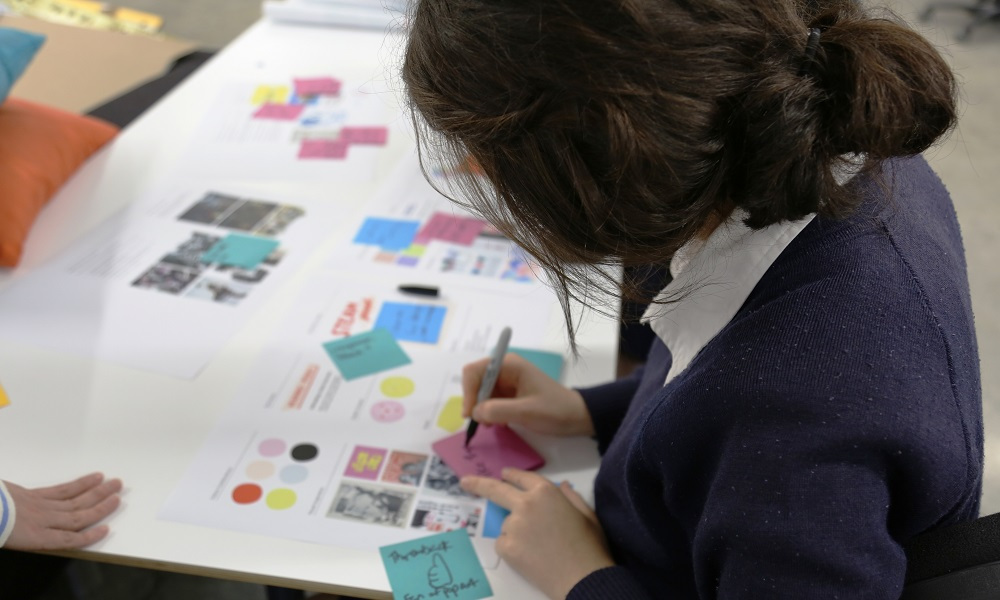The STEAMpunk Girls project that launched this month involves researchers from University of Technology Sydney working with students and teachers from four high schools to co-design a project-based learning program. In today's Q&A, we find out more from Tida Tippapart (Hatchery Program Manager at UTS and one of the key staff members working on the STEAMpunk Girls program) and one of the teachers involved, Lisa Wark (Head Teacher TAS – Technological and Applied Studies – at Riverside Girls High School).
What is STEAMpunk girls, and why STEAM instead of STEM?
Tida Tippapart: STEAMpunk Girls has a vision of a more innovative Australia where young women have agency and are positioned as active change agents to Australia's innovation sector. It aims to create a space where young women can influence the conversation around STEAM education.
STEAMpunk Girls is an educational program that advocates for young women (ages 12 to 16) to challenge why STEAM is important for careers of the future. This program exposes students to the STEAM industries and female role models working with and across these fields.
It provides a safe and experimental environment that promotes a ‘learn by doing' mindset and encourages young women to apply interdisciplinary approaches to solving real world issues. Our point of difference is the inclusion of entrepreneurial methods as the cornerstone of the program.
Whilst the acronym STEAM stand for Science, Technology, Engineering, Art and Maths, the program looks to broaden the definition to look at transdisciplinary ways of working. We don't want to limit the students to thinking that the disciplines are siloed, instead we want the students to imagine STEAM education as space for them to explore the possibilities of how the disciplines work together. STEAM education empowers students to develop foundational skills needed for the contemporary workforce. This cross-disciplinary, integrated style of education equips students with interdisciplinary and innovative skills such as entrepreneurial and design thinking, and critical thinking capacities.
Who is involved in the project and how long will it run for?
TT: The program will run a pilot session from May (Term 2) until mid-August. During the pilot we will work with four schools from inner-city Sydney and Western Sydney to test some of the content we have developed. The program will be a blended PBL experience, the participating students will be invited to come to UTS to take part in think tanks and workshops that are designed to expose the students to some of UTS' unique programs, research units and facilities. The students will then be asked to create projects over the course of the term. These projects will be tied in with the National Science Week's Agenda on ‘future earth'. The students will work on developing projects that will then be presented at a final showcase in August as part of the Sydney Science Festival.
Lisa, you're one of the teachers involved. Why is STEAM education important from your school's perspective, and particularly for girls?
Lisa Wark: As Head Teacher TAS (Technological and Applied Studies), I currently supervise nine experienced staff members and one beginning teacher who teach subjects within this key learning area. The subjects taught in our faculty at Riverside include:
- Years 7-8: Technology Mandatory, Information and Communication Technology;
- Years 9-10: Food Technology, Textiles Technology, Graphics Technology, Industrial Technology- Timber, Information and Software Technology; and,
- Years 11-12: Engineering Studies, Community and Family Studies, Textiles and Design, Industrial Technology-Multimedia and Hospitality.
The school has a strong tradition of academic excellence achieved through inspired teaching. Students are articulate and passionate about having a voice which they achieve through many activities including involvement in the community.
The first time I taught senior computing was in 1991 at a girl's school in South Western Sydney where we had five classes in that subject. However, over subsequent years the numbers opting to pursue Information and Communication Technology based courses, especially in the senior years, began to decline.
Unfortunately, at Riverside I have also witnessed the continued decline in girls selecting these subjects, not only in the senior years, but also as a pattern of study in Stage 5, Years 9 and 10. The Science faculty at the school were also experiencing similar issues. A time for change had arrived, so in 2015, driven by the Head Teacher Curriculum, the school embarked on developing a STEM growth model. Adopting a growth model recognised and supported the need for professional learning of staff.
The students we currently teach face uncertainty about career opportunities and future jobs. The job market is also becoming increasingly global and interest in Science, Engineering and Technology careers is diminishing especially for girls. To help address this situation we have focused on strategies and curriculum opportunities to build capacity in our students to be flexible, resilient, see and act on opportunities as well as innovate.
STEM at Riverside Girls High School provides experiences for our students to develop creative and collaborative approaches to solve complex problems, critically think, take initiative for their own learning, see and act on opportunities as well as innovate. It is particularly important that our young women realise that they have a voice that can be heard and potentially make significant differences in the world, our entrepreneurship unit of work and Young Change Agents projects supported this concept. However, engaging students interest in STEM options still proves to be challenging.
We needed to find pathways to ignite STEM passions of our female students who tend to adopt a more traditional pattern of study so a connection with the Arts provides one avenue. Introducing such things as wearable technology units of work, using 3D printing to create fabric for costumes or creating interactive art installations can help students see STEM in action and spark their enthusiasm. Promoting a STEAM approach at Riverside has been one way to engage and stimulate student interest and develop cross curriculum opportunities. However, it is still essential that the focus remain on STEM related activities in these cross-curriculum opportunities. Using the “how might we...” questions to stimulate creative and critical thinking about the world around them provides fantastic STEAM opportunities that engage our female students.
At Riverside, it has been determined that greater long-term impact and benefit for students is gained through incorporation of STEM activities within the curriculum. We do engage in extra -curricular opportunities such as Young Change Agents, Women in IT and Engineering when the opportunity arises. All Year 7 and 8 students are involved in STEM related teaching and learning activities through the Information and Communication Technologies (ICT) classes. The Year 8 ICT students also complete an integrated unit of work titled Post Earth Pioneers.
What's it been like to be involved in the co-designing model?
LW: It was an invaluable opportunity as a teacher to take part in this co-designing model to develop a project curriculum. As teachers, we don't often take the opportunity to work with our students in gaining real empathy to develop our teaching and learning programs and units of work. This is a very powerful tool to employ in a school setting as those who take part in the process have a greater sense of ownership and potentially work harder to ensure its success. I have since used this concept to co-design an assessment regime for Year 10 Textiles Technology students.
In addition, being able to express our thoughts and opinions with a researcher in the field was also empowering. Throughout the process it was made clear to us that our opinions and that of our students were valued. During the program the students were fully engaged in the activities and felt empowered by the process. They were very keen to return to school and interview students to gain empathy about STEM/STEAM. The tour of the University gave the students a good insight into opportunities, with the 360 data room the highlight. Our students have shared their experiences with our parent community at one of our STEM morning teas, which was well received.
Tida, why did you decide to use the co-design approach? Is it fair to say you'll be designing ‘on the go' then, from the student and teacher feedback and input at various stages?
TT: Yes, the co-design element is a really important feature of the program because it has given us the time to develop the program in consultation with the students and really understand their pain points and aspirations. Working closely with the teachers has also been an incredible opportunity to find out how the program can support teachers with resources and creating a community of practice so that teachers can share knowledge.
The designing as you go method is very much because we are constantly learning and adapting as we go, it's about applying that start up mentality.
The pilot is officially launched on May 25, but a lot has already happened hasn't it?
On 15 November we invited three schools to participate in the co-design process of the program. The co-design workshops were created to explore how young women would engage with STEAM content. The three participating schools were chosen based on an identified interest in or talent for STEAM education. The importance of representing young women from low SES areas and existing engagement with UTS also played a role in choosing the schools to participate.
The participating students were invited to an introduction into STEAM and heard from guest speakers working across these fields to help them understand how STEAM involves an integration and interconnection of different disciplines and the resulting opportunities for collaboration and the development of new products, services and ways to problem solve complex issues. The students then came to the Hatchery to undertake a small design thinking workshop that used some of the Hatchery content to inform the design thinking approach. The students were then given a basic introduction into empathy and interviewing techniques, with the aim that students would then go back to the schools to interview other girls on the value of the arts and its importance to STEM and STEAM education.
On 25 November, the students came back to UTS to unpack their findings and to begin to ideate potential content ideas and themes. The girls were asked to design a STEAM school of the future which yielded some interesting themes and contents ideas that can be used for the pilot. They also had the opportunity to explore different branding options for the program and identify which elements they positively related to STEAM.
The co-design workshops were highly successful with both students and teachers engaged with the content and experimental nature of the workshops. There were key themes that emerged from the workshops that included how entrepreneurship could be fused into the program, and an interest in topics such as space, sustainability and design.
And what are the next steps?
TT: We're testing out our methods and piloting the content in Term 2 with four different schools. The pilot will be a mixture of PBL and think tanks to create an immersive learning experience that stretches from May to August. We are working on creating a program that will support young women to develop entrepreneurial projects that incorporate elements from different STEAM fields. A large component of the program has been modelled off the learnings and teachings from UTS:Hatchery, an extracurricular program that supports students to develop their entrepreneurial skillsets.
In what ways do you encourage female students to continue with STEAM studies into senior high school and beyond?
Do you use classroom activities that reflect the real-life situations students are likely to face once they leave school?
When promoting STEAM study and careers, do you use both male and female role models?



